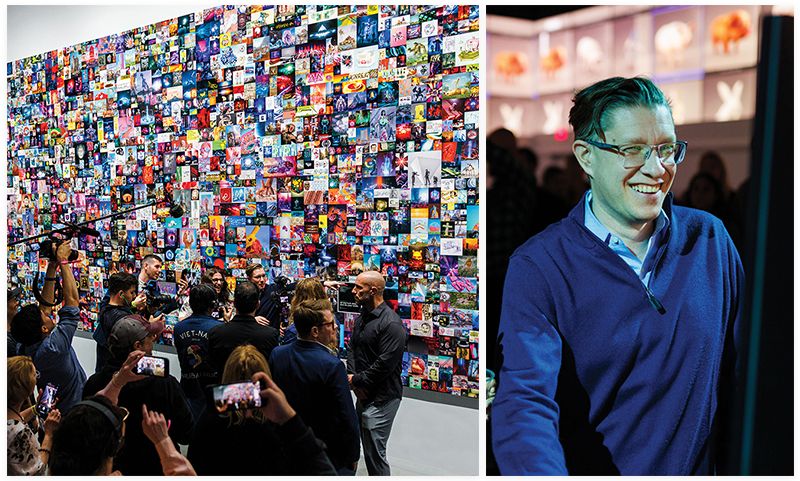The digital artist known for his “Everydays” project recently opened Beeple Studios to celebrate “digital weirdness”

Mike Winkelmann, aka Beeple, has been creating an original work every day and posting it online for 5,929 days and counting; his digital collage of the first 5,000 days sold via an NFT for $69.3 million in 2021.
The traditional art world was upended in March 2021 when Mike Winkelmann, aka Beeple, made global headlines for selling a digital collage via a non-fungible token (NFT) through the venerable Christie’s auction house. The $69.3-million sale made the 42-year-old Wisconsin native one of the world’s most valuable living artists and made many others scratch their heads. What’s an NFT anyway? And what’s digital art for that matter? Also, who is this Beeple dude? And, wait, he lives in North Charleston?
But for his legion of fans (2.3 million Instagram followers, for starters) who have tracked his career in animation and daily digital art-making, Beeple’s success has been less a meteoric rise than a factor of the rest of the world, and authentication technology, finally catching up to him. We caught up with him, too, to learn more about his new 50,000-square-foot Beeple Studios (“a place for digital weirdness”) and what juices his creative life.
Creative Evolution: Well, this wasn’t exactly chosen as a path. I went to school [Purdue University] to study computer science, and once there, I pretty quickly started making short films and weird abstract digital art. I slogged through the degree and assumed after graduating I’d pay the bills doing web design, then put my energy into making my own work. There was no meaningful way back then to “collect” digital art, so I put my art out for free on Creative Commons, making one new image every day from scratch. Slowly, I started growing my audience and getting better freelance work, like concert visuals for Justin Bieber and Katy Perry, then when NFTs finally came along, I was already one of the most popular digital artists. Four months after I learned about NFTs, the Christie’s auction happened. It’s all ramped up very quickly from there.

Winkelmann hosted a grand opening for the 50,000-square-foot Beeple Studios in March and has hosted community nights to celebrate digital art on a large scale.
Understanding Digital Art: It’s so interesting because digital art is the predominant visual language that we all see and experience—all the apps we use, the advertisements we see, the movies and TV we watch, the video games we play—those are all made by digital artists, not by painters and sculptors. It’s something we all take for granted yet don’t fully consider “art,” but this attitude is changing. What I’m doing isn’t really that different from someone painting a picture; I’m just using different tools. I believe in the future far more people will be making art on the computer than using a paintbrush.
“Everydays” Lessons: It’s hard to imagine any of the things that have happened in my career without the “Everydays” project; for 16 years it’s been such a massive part of my practice, and so many things have spawned off that. I’m trying to show you something you’ve never seen before, and that’s why a lot of my pictures tend to be pretty weird. The discipline to get something out each day helps me work through ideas much quicker. It’s definitely challenging, because contrary to popular belief, I don’t wake up every day magically inspired to create something new. There are plenty of nights at 9:30 p.m., after a full day of other work and building this studio, when the last thing I want to do is sit at the computer for another two hours. But I don’t know anyone who’s done it daily this long, so we’re going to see it through.
His Vision for Beeple Studios: We just opened in March, so we’re still figuring out what all we can use this space for. We have a number of events coming up in the fall, but it’s really about creating events to bring people together, connect, and celebrate digital art.